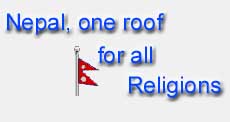|
|
|
|
WITHIN THE VALLEY |
Beyond the valley in detail |
|
||
AttractionsKathmanduThe country's capital and largest city simultaneously reeks of history and the wear and tear of increasing modernity. The tightly packed historical center, with its squares and temples, continues to preserve a world light years away from the shantytowns, expensive hotels, restaurants and shops on the city's outskirts. Kathmandu's core is Durbar Square, with the Vishnumati River to the west and Ratna Park to the east. The Bagmati River forms the southern boundary, while Thamel, the budget travelers' hangout, sprawls to the north. : Kathmandu is really two cities: a fabled capital of convivial pilgrims and carved rose-brick temples; and a splenetic sprawl smothered in the pollution of diesel fumes, dirt, monkeys and beggars. The sights are heavily clustered in the old part of town from Kantipath west towards the Vishumati River. Creativity and patience are required to navigate the city's narrow, often unmarked streets. BhaktapurBhaktapur is in many ways the most medieval of the three major cities in the Kathmandu Valley. Despite recent development, the city still retains a distinctly timeless air with much of its glorious architecture dating from the end of the 17th century. Most sights can be easily traversed by foot and include yet another Durbar Square, which is infinitely larger than Kathmandu's and has its fair share of temples, statues and columns, many with grisly histories behind them. For instance, the sculptor of the Ugrachandi & Bhairab Statues had his hands chopped off to prevent him from duplicating his masterpieces. Bhakatapur's second main square is Taumadhi Tole, which features Nyatapola, the highest temple in the valley, and Til Mahadev Narayan, an important place of pilgrimage. Nearby is Potters' Square, where thousands of clay pots are made and sold. East from here, through the sinuous streets of the old city centre, is Tachupal Tole, another square containing temples and monasteries plus craft museums. Sometimes it's best to take a break from temples and sit back and watch the unchanging rituals of daily life: the laying out of grain to dry in the sun; families collecting water or washing under communal taps; children playing simple games; dyed yarns flapping in the breeze; or potters at work throwing clay.
BEYOND THE VALLEY IN
DETAIL
By the way did you know that Religion is the
lifeblood of the Nepalese?
Officially it is a Hindu country, but in practice the religion is a syncretism of Hindu and |
|
PatanPatan, the second-largest city in the valley, lies just across the Bagmati River from Kathmandu, but it's a much quieter and less frenetic place to visit. The city is justly proud of its temples and artisans and it is their handiwork that provides the focus of the stunning Durbar Square - choc-a-block with the largest display of Newari architecture in Nepal. It includes the Royal Palace, which contains a richly decorated bathtub, and the two-tiered brick Jagannarayan Temple. Look up to the roof struts to see carvings of figures engaged in quite athletic acts of intercourse. A few minutes' walk north of the square is the Golden Temple, a Buddhist monastery guarded by sacred tortoises that potter around the courtyard; and the Kumbeshawar, reputedly the oldest (1392) temple in Patan. South of the square is an area of charming streets lined with metal smiths and brassware shops. Patan's other attractions are flung further a field. Among them is a collection of four stupas, thought to have been built over 2500 years ago, and Nepal's only zoo, which features a reasonable assortment of rhinos, tigers, leopards and bird life. Around the Kathmandu ValleyApart from Kathmandu, Patan and Bhaktapur, there are a number of other fascinating villages, temples and stupas scattered around the valley. One of these is probably the best known site in Nepal - the Buddhist temple of Swayambhunath. The temple is colloquially known as the 'monkey temple', after the large tribe of garrulous monkeys which guard the hill, amusing visitors and devotees with their tricks, including sliding gracefully down the long double banisters of the main stairway. The soaring central stupa is topped by an aureate block featuring the watchful eyes of Buddha. Set around the base is a continuous series of prayer wheels which pilgrims, circumambulating the stupa, spin as they pass by. Beyond Swayambhunath, on the banks of the Bagmati River, is Pashupatinath, the country's pre-eminent Hindu temple and one of the most significant Shiva temples on the subcontinent. As the Bagmati is a holy river, Pashupatinath has become a popular place to be cremated - the ghats (river steps) immediately in front of the temple are reserved for the cremation of royalty, while those a little further south are for the riff-raff. Another site with a religious bent is the huge stupa of Bodhnath, which is the largest in the country and among the largest in the world. It's also the center for Nepal's considerable population of Tibetans. Late afternoon is a good time to visit. This is when prayer services are held and the locals turn out to walk around the stupa (if you want to join in, remember to walk in a clockwise direction). Surrounding Bodhnath are a number of monasteries, but be discreet and respectful if you intend visiting them. The valley also offers plenty of opportunities to get off the beaten track, with treks to and from the resort villages of Nagarkot and Dhulikhel; wallowing in Tatopani's hot springs; exploring cloud forests in Pulchowki; and mountain biking in the regions of Chapagaon and Bungamati. |
||
|
|
||||
|
|
||||
|
|
||||

